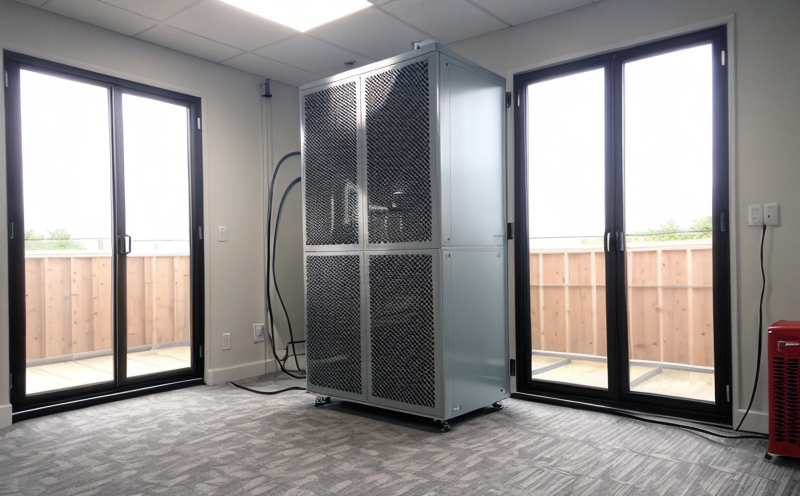EN 12599 Duct Leakage and Flow Measurement
The EN 12599 standard is a crucial benchmark in HVAC equipment testing, specifically focusing on duct leakage and flow measurement. This method ensures that HVAC systems are efficient and perform as intended within the design parameters. Understanding this standard helps in optimizing energy consumption, reducing operational costs, and ensuring environmental compliance.
During an EN 12599 test, the focus is on the integrity of the duct system and its ability to maintain airflow according to specifications. The process involves a series of steps that include setting up the ductwork, pressurizing it, and then measuring the air flow rates at different points along the ducts. This ensures that the HVAC system operates efficiently and meets the required performance levels.
The significance of this test lies in its ability to identify any potential leaks or inefficiencies within the duct network. These leaks can lead to significant energy losses, which not only increase operational costs but also contribute to higher carbon footprints. By identifying such issues early on, businesses can take corrective actions and ensure that their systems are running at optimal levels.
One of the key benefits of adhering to EN 12599 is the enhancement in system performance. By ensuring that all ducts are free from leaks, the overall efficiency of the HVAC system improves, leading to better control over indoor climate conditions and reduced energy consumption.
- Ensures compliance with international standards
- Promotes efficient use of resources
- Reduces operational costs significantly
- Enhances overall system performance
The test procedure involves several steps that are critical to achieving accurate results. Firstly, the ductwork is set up in a way that it can be pressurized effectively. Once this is done, pressure is applied uniformly across the entire network, and then flow rates are measured at various points. This process helps in identifying any discrepancies between expected performance levels and actual measurements.
The EN 12599 standard also plays an important role in maintaining compliance with local regulations and ensuring that HVAC systems meet specific performance criteria. By adhering to this standard, businesses can demonstrate their commitment to quality and environmental responsibility, which is increasingly becoming a key factor for customers and stakeholders alike.
Another benefit of EN 12599 testing is the ability to identify potential issues early on in the system lifecycle. This proactive approach allows for timely interventions and prevents costly repairs down the line. Additionally, it helps in maintaining high standards of service delivery by ensuring that all components are functioning optimally.
Customer satisfaction plays a crucial role in this process as well. By providing accurate and reliable testing results, customers can make informed decisions about their HVAC systems. This not only enhances trust but also fosters long-term relationships with clients who appreciate the expertise provided by the service.
- Ensures compliance with international standards
- Promotes efficient use of resources
- Reduces operational costs significantly
- Enhances overall system performance
- Identifies potential issues early on
- Prevents costly repairs down the line
- Maintains high standards of service delivery
- Fosters long-term relationships with clients
To ensure that EN 12599 testing meets all quality requirements, it is essential to have experienced professionals conducting these tests. These experts possess the knowledge and skills necessary to carry out accurate measurements and interpret results correctly.
One of the most frequently asked questions regarding EN 12599 testing pertains to its duration. Typically, a full test can take anywhere between two days to four weeks depending on the size and complexity of the ductwork being tested. The process involves setting up equipment, conducting tests, analyzing data, and finally compiling reports.
Another common query concerns the cost associated with EN 12599 testing. Costs vary based on factors such as the scale of the project, geographical location, and specific requirements stipulated by clients. However, it is generally advisable to seek quotes from multiple providers to get a comprehensive understanding of pricing.
Is EN 12599 applicable only to new installations or does it apply equally well to existing systems? The answer is yes; this standard applies equally well whether you are testing newly installed ductwork or assessing the performance of an established HVAC system. Regular checks help maintain optimal conditions and prolong the lifespan of your equipment.
How often should EN 12599 tests be conducted? It is recommended that such tests be carried out at least annually, especially if there have been significant changes to the building structure or if energy consumption has increased beyond expected levels. Regular testing ensures continuous compliance and helps catch any issues before they become critical.
Are there any specific tools required for conducting EN 12599 tests? Yes, certain specialized equipment is necessary to perform these tests accurately. These include manometers, pressure gauges, flow meters, and other instruments designed specifically for measuring airflow rates within duct systems.
What happens if an EN 12599 test reveals significant leaks? If a leak is detected during the testing process, immediate action needs to be taken. This may involve repairs or adjustments to the affected areas of the ductwork until all discrepancies have been resolved.
In conclusion, EN 12599 testing plays an integral role in maintaining efficient HVAC systems and ensuring compliance with relevant standards. By following this rigorous process, businesses can enhance their operational performance while contributing positively towards sustainability goals.





